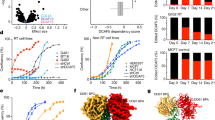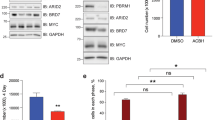Abstract
Sirtuin proteins regulate diverse cellular pathways that influence genomic stability, metabolism and ageing1,2. SIRT7 is a mammalian sirtuin whose biochemical activity, molecular targets and physiological functions have been unclear. Here we show that SIRT7 is an NAD+-dependent H3K18Ac (acetylated lysine 18 of histone H3) deacetylase that stabilizes the transformed state of cancer cells. Genome-wide binding studies reveal that SIRT7 binds to promoters of a specific set of gene targets, where it deacetylates H3K18Ac and promotes transcriptional repression. The spectrum of SIRT7 target genes is defined in part by its interaction with the cancer-associated E26 transformed specific (ETS) transcription factor ELK4, and comprises numerous genes with links to tumour suppression. Notably, selective hypoacetylation of H3K18Ac has been linked to oncogenic transformation, and in patients is associated with aggressive tumour phenotypes and poor prognosis3,4,5,6. We find that deacetylation of H3K18Ac by SIRT7 is necessary for maintaining essential features of human cancer cells, including anchorage-independent growth and escape from contact inhibition. Moreover, SIRT7 is necessary for a global hypoacetylation of H3K18Ac associated with cellular transformation by the viral oncoprotein E1A. Finally, SIRT7 depletion markedly reduces the tumorigenicity of human cancer cell xenografts in mice. Together, our work establishes SIRT7 as a highly selective H3K18Ac deacetylase and demonstrates a pivotal role for SIRT7 in chromatin regulation, cellular transformation programs and tumour formation in vivo.
This is a preview of subscription content, access via your institution
Access options
Subscribe to this journal
Receive 51 print issues and online access
$199.00 per year
only $3.90 per issue
Buy this article
- Purchase on SpringerLink
- Instant access to full article PDF
Prices may be subject to local taxes which are calculated during checkout




Similar content being viewed by others
Accession codes
Primary accessions
Gene Expression Omnibus
Data deposits
The SIRT7 ChIP-sequencing data are deposited in NIH Gene Expression Omnibus under accession number GSE28149. In addition, raw and processed data are available on our project website, http://dldcc-web.brc.bcm.edu/lilab/SIRT7/.
References
Haigis, M. C. & Sinclair, D. A. Mammalian sirtuins: biological insights and disease relevance. Annu. Rev. Pathol. 5, 253–295 (2010)
Longo, V. D. & Kennedy, B. K. Sirtuins in aging and age-related disease. Cell 126, 257–268 (2006)
Ferrari, R. et al. Epigenetic reprogramming by adenovirus e1a. Science 321, 1086–1088 (2008)
Horwitz, G. A. et al. Adenovirus small e1a alters global patterns of histone modification. Science 321, 1084–1085 (2008)
Manuyakorn, A. et al. Cellular histone modification patterns predict prognosis and treatment response in resectable pancreatic adenocarcinoma: results from RTOG 9704. J. Clin. Oncol. 28, 1358–1365 (2010)
Seligson, D. B. et al. Global levels of histone modifications predict prognosis in different cancers. Am. J. Pathol. 174, 1619–1628 (2009)
Vakhrusheva, O. et al. Sirt7 increases stress resistance of cardiomyocytes and prevents apoptosis and inflammatory cardiomyopathy in mice. Circ. Res. 102, 703–710 (2008)
Michishita, E., Park, J. Y., Burneskis, J. M., Barrett, J. C. & Horikawa, I. Evolutionarily conserved and nonconserved cellular localizations and functions of human SIRT proteins. Mol. Biol. Cell 16, 4623–4635 (2005)
Hassig, C. A. et al. A role for histone deacetylase activity in HDAC1-mediated transcriptional repression. Proc. Natl Acad. Sci. USA 95, 3519–3524 (1998)
Wang, Z. et al. Combinatorial patterns of histone acetylations and methylations in the human genome. Nature Genet. 40, 897–903 (2008)
Steeg, P. S. et al. Evidence for a novel gene associated with low tumor metastatic potential. J. Natl. Cancer Inst. 80, 200–204 (1988)
Leal, J. F. et al. Cellular senescence bypass screen identifies new putative tumor suppressor genes. Oncogene 27, 1961–1970 (2008)
Bryne, J. C. et al. JASPAR, the open access database of transcription factor-binding profiles: new content and tools in the 2008 update. Nucleic Acids Res. 36, D102–D106 (2008)
Galang, C. K., Muller, W. J., Foos, G., Oshima, R. G. & Hauser, C. A. Changes in the expression of many Ets family transcription factors and of potential target genes in normal mammary tissue and tumors. J. Biol. Chem. 279, 11281–11292 (2004)
Kaikkonen, S., Makkonen, H., Rytinki, M. & Palvimo, J. J. SUMOylation can regulate the activity of ETS-like transcription factor 4. Biochim. Biophys. Acta 1799, 555–560 (2010)
O’Geen, H. et al. Genome-wide binding of the orphan nuclear receptor TR4 suggests its general role in fundamental biological processes. BMC Genomics 11, 689 (2010)
Ashraf, N. et al. Altered sirtuin expression is associated with node-positive breast cancer. Br. J. Cancer 95, 1056–1061 (2006)
de Nigris, F. et al. Isolation of a SIR-like gene, SIR-T8, that is overexpressed in thyroid carcinoma cell lines and tissues. Br. J. Cancer 86, 917–923 (2002)
Frye, R. ‘SIRT8’ expressed in thyroid cancer is actually SIRT7. Br. J. Cancer 87, 1479 (2002)
Makkonen, H. et al. Identification of ETS-like transcription factor 4 as a novel androgen receptor target in prostate cancer cells. Oncogene 27, 4865–4876 (2008)
Braithwaite, A. W. et al. Adenovirus-induced alterations of the cell growth cycle: a requirement for expression of E1A but not of E1B. J. Virol. 45, 192–199 (1983)
Amsterdam, A. et al. Many ribosomal protein genes are cancer genes in zebrafish. PLoS Biol. 2, E139 (2004)
Ebert, B. L. et al. Identification of RPS14 as a 5q- syndrome gene by RNA interference screen. Nature 451, 335–339 (2008)
Ford, E. et al. Mammalian Sir2 homolog SIRT7 is an activator of RNA polymerase I transcription. Genes Dev. 20, 1075–1080 (2006)
Hansen, M. et al. Lifespan extension by conditions that inhibit translation in Caenorhabditis elegans . Aging Cell 6, 95–110 (2007)
Harrison, D. E. et al. Rapamycin fed late in life extends lifespan in genetically heterogeneous mice. Nature 460, 392–395 (2009)
Lombard, D. B., Schwer, B., Alt, F. W. & Mostoslavsky, R. SIRT6 in DNA repair, metabolism and ageing. J. Intern. Med. 263, 128–141 (2008)
Michishita, E. et al. SIRT6 is a histone H3 lysine 9 deacetylase that modulates telomeric chromatin. Nature 452, 492–496 (2008)
Dahl, J. A. & Collas, P. Q2ChIP, a quick and quantitative chromatin immunoprecipitation assay, unravels epigenetic dynamics of developmentally regulated genes in human carcinoma cells. Stem Cells 25, 1037–1046 (2007)
Chua, K. F. et al. Mammalian SIRT1 limits replicative life span in response to chronic genotoxic stress. Cell Metab. 2, 67–76 (2005)
Mendez, J. & Stillman, B. Chromatin association of human origin recognition complex, cdc6, and minichromosome maintenance proteins during the cell cycle: assembly of prereplication complexes in late mitosis. Mol. Cell. Biol. 20, 8602–8612 (2000)
Hung, T. et al. ING4 mediates crosstalk between histone H3 K4 trimethylation and H3 acetylation to attenuate cellular transformation. Mol. Cell 33, 248–256 (2009)
Shi, X. et al. ING2 PHD domain links histone H3 lysine 4 methylation to active gene repression. Nature 442, 96–99 (2006)
Garcia, B. A. et al. Chemical derivatization of histones for facilitated analysis by mass spectrometry. Nature Protocols 2, 933–938 (2007)
Plazas-Mayorca, M. D. et al. One-pot shotgun quantitative mass spectrometry characterization of histones. J. Proteome Res. 8, 5367–5374 (2009)
Rappsilber, J., Ishihama, Y. & Mann, M. Stop and go extraction tips for matrix-assisted laser desorption/ionization, nanoelectrospray, and LC/MS sample pretreatment in proteomics. Anal. Chem. 75, 663–670 (2003)
Moqtaderi, Z. et al. Genomic binding profiles of functionally distinct RNA polymerase III transcription complexes in human cells. Nature Struct. Mol. Biol. 17, 635–640 (2010)
Zhang, Y. et al. Model-based analysis of ChIP-Seq (MACS). Genome Biol. 9, R137 (2008)
Dennis, G., Jr et al. DAVID: Database for Annotation, Visualization, and Integrated Discovery. Genome Biol. 4, 3 (2003)
Huang da. W. Sherman, B. T. & Lempicki, R. A. Systematic and integrative analysis of large gene lists using DAVID bioinformatics resources. Nature Protocols 4, 44–57 (2009)
Liu, X. S., Brutlag, D. L. & Liu, J. S. An algorithm for finding protein-DNA binding sites with applications to chromatin-immunoprecipitation microarray experiments. Nature Biotechnol. 20, 835–839 (2002)
Mahony, S. & Benos, P. V. STAMP: a web tool for exploring DNA-binding motif similarities. Nucleic Acids Res. 35, W253–W258 (2007)
Acknowledgements
We thank M. Snyder and colleagues for high-throughput sequencing (conducted as part of the ENCODE consortium), and members of the Chua and Gozani laboratories for discussions and comments on the manuscript. This work was supported by grants from the National Institutes of Health (NIH) to K.F.C. (K08 AG028961, R01 AG028867), W.L. (U01DA025956), O.G. (R01 GM079641), K.S. (GM 30186, HG 4558) and B.A.G. (DP2OD007447); from the National Science Foundation to B.A.G. (CAREER Award, CBET-0941143); from the Department of Defense to W.L. (PC094421); from the Cancer Prevention and Research Institute of Texas (CPRIT) to W.L. (RP110471-C3); from the Department of Veterans Affairs to K.F.C. (Merit Award); and by fellowship awards to M.F.B. (ARCS Scholarship and Mason Case Graduate Fellowship), R.I.T. (NIH training grant 1018438-142 PABCA), L.T. (American Italian Cancer Foundation Post-doctoral Research Fellowship), S.P. (NIH training grant 3T32DK007217-36S1) and N.L.Y. (NIH F32 NRSA). W.L. is a recipient of a Duncan Scholar Award. K.F.C. is a Paul Beeson Scholar and an Ellison Medical Foundation New Scholar in Aging.
Author information
Authors and Affiliations
Contributions
M.F.B. and K.F.C. conceived the project and, with E.M.-K. and O.G., designed the experiments. M.F.B. and E.M.-K. performed and interpreted molecular and cell biology experiments, and M.F.B. and K.F.C. wrote the manuscript with input from co-authors. Y.X., K.C. and W.L. performed the bioinformatic analyses and wrote the corresponding manuscript sections. Z.M. and K.S. designed and performed the SIRT7 ChIP-sequencing experiments. L.T. performed and interpreted the experiments in Supplementary Fig. 17; B.A.G. and N.L.Y. performed the quantitative mass spectrometry in Fig. 1g; M.K. performed the mouse xenograft experiments in Fig. 4; R.I.T. and S.P. generated constructs for various experiments and provided technical assistance. M.F.B., E.M.-K. and Y.X. made independent contributions to the work.
Corresponding authors
Ethics declarations
Competing interests
The authors declare no competing financial interests.
Supplementary information
Supplementary Information
This file contains Supplementary Figures 1-20 and Supplementary Tables 1 and 4-8 (see separate files for Tables 2, 3 and 9). (PDF 1389 kb)
Supplementary Table 2
This table contains SIRT7 ChIP-seq peak list with annotated genes. The peaks were called by MACS with p-value cut-off 1e-8. (XLS 51 kb)
Supplementary Table 3
This table contains SIRT7 ChIP-seq target gene list. The target genes were identified by detecting SIRT7 peaks within 3Kbp upstream to 3Kbp downtream of transcription start sites (TSS). (XLS 67 kb)
Supplementary Table 9
This table contains ELK4 ChIP-seq peak list with annotated genes. The raw reads were obtained from O'Geen and Lin et al, BMC Genomics 2010, 11:689 (GSE24685), and were remapped to hg18 genome. The peaks were called by MACS with p-value cut-off 1e-8. The target genes were identified by detecting ELK4 peaks within 3Kbp upstream to 3Kbp downtream of transcription start sites (TSS). (XLS 216 kb)
Rights and permissions
About this article
Cite this article
Barber, M., Michishita-Kioi, E., Xi, Y. et al. SIRT7 links H3K18 deacetylation to maintenance of oncogenic transformation. Nature 487, 114–118 (2012). https://doi.org/10.1038/nature11043
Received:
Accepted:
Published:
Issue Date:
DOI: https://doi.org/10.1038/nature11043
This article is cited by
-
SIRT6 in Regulation of Mitochondrial Damage and Associated Cardiac Dysfunctions: A Possible Therapeutic Target for CVDs
Cardiovascular Toxicology (2024)
-
IGF1R-phosphorylated PYCR1 facilitates ELK4 transcriptional activity and sustains tumor growth under hypoxia
Nature Communications (2023)
-
Epigenetic regulation of beta-endorphin synthesis in hypothalamic arcuate nucleus neurons modulates neuropathic pain in a rodent pain model
Nature Communications (2023)
-
SIRT7 orchestrates melanoma progression by simultaneously promoting cell survival and immune evasion via UPR activation
Signal Transduction and Targeted Therapy (2023)
-
Functional Diversity of SIRT7 Across Cellular Compartments: Insights and Perspectives
Cell Biochemistry and Biophysics (2023)



